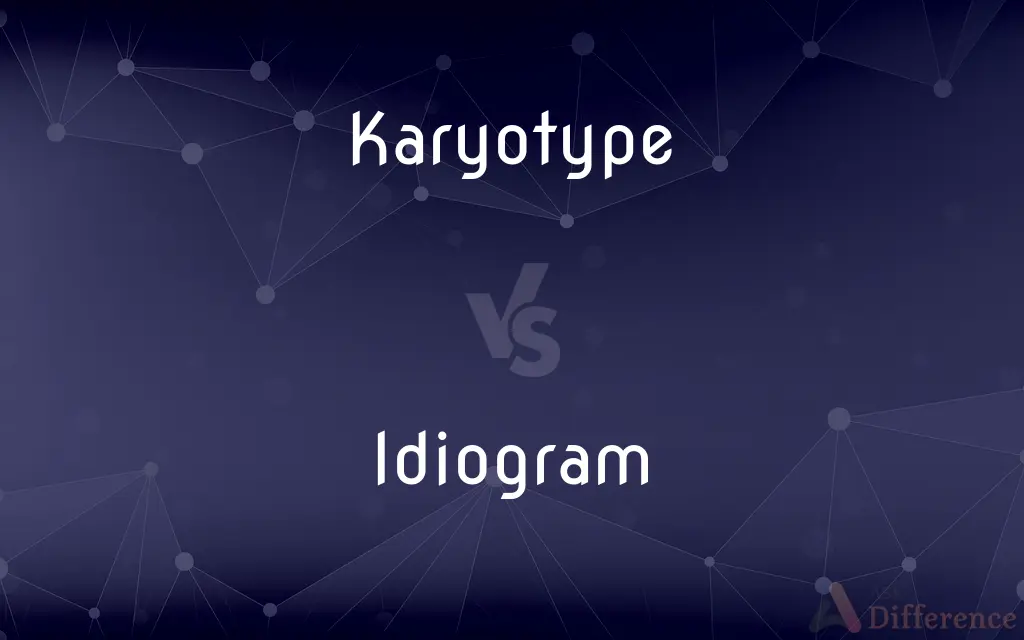Karyotype vs. Idiogram — What's the Difference?
By Fiza Rafique & Maham Liaqat — Updated on May 8, 2024
A karyotype displays the actual photographs of chromosomes arranged in pairs, highlighting structural details, while an idiogram is a simplified diagrammatic representation, emphasizing chromosome banding and morphology.

Difference Between Karyotype and Idiogram
Table of Contents
ADVERTISEMENT
Key Differences
A karyotype is an image-based depiction of an organism's full set of chromosomes, organized typically during metaphase of cell division. On the other hand, an idiogram serves as a schematic representation of these chromosomes, focusing on illustrating their size, banding pattern, and centromere position.
In karyotyping, chromosomes are stained, photographed, and arranged according to size and structure, which aids in identifying chromosomal abnormalities. Whereas, idiograms use lines or bars to symbolize chromosomes, providing a more abstract, yet informative view of chromosomal features.
Karyotypes are crucial in clinical settings, such as prenatal screening and cancer diagnosis, because they reveal the actual chromosomal structures and anomalies. In contrast, idiograms are often used in genetic mapping and education to simplify the understanding of chromosome organization.
The preparation of a karyotype requires live cells, which must undergo cell division and be arrested in metaphase to visualize the chromosomes. Conversely, idiograms can be created from existing karyotype data and do not require live cell preparations.
While karyotypes provide a real-life snapshot of an organism's chromosomes, making them invaluable for detailed chromosomal analysis, idiograms are advantageous for their ease of use in comparative genetics and large-scale genetic studies.
ADVERTISEMENT
Comparison Chart
Definition
Actual photograph of chromosomes, arranged in pairs.
Diagrammatic representation of chromosomes.
Purpose
Identification of chromosomal abnormalities in detail.
Simplified understanding and comparison of chromosomes.
Usage
Clinical diagnostics and research.
Genetic mapping and education.
Preparation
Requires cell culture and metaphase arrest.
Can be constructed from karyotype data without live samples.
Detail
Shows detailed chromosomal structure and abnormalities.
Focuses on chromosome size, banding patterns, and position.
Compare with Definitions
Karyotype
Used to detect chromosomal abnormalities and configurations.
Abnormalities in a karyotype can indicate potential genetic disorders.
Idiogram
Useful in genetic education and mapping.
Idiograms are essential tools in genetics lectures.
Karyotype
A complete set of chromosomes in an individual, organized in pairs.
A karyotype is often analyzed in prenatal testing.
Idiogram
A schematic representation of chromosome structure.
Idiograms help in understanding chromosome banding.
Karyotype
A method used in genetics to visualize chromosomes.
Doctors use karyotyping to detect Down syndrome.
Idiogram
Diagram used to represent the relative size and banding of chromosomes.
Geneticists use idiograms to map genes.
Karyotype
Depicts the chromosomal makeup of an organism.
A normal human karyotype includes 46 chromosomes.
Idiogram
Focuses on highlighting key chromosomal features.
Centromere positions are clearly marked on idiograms.
Karyotype
Involves staining and photographing chromosomes during metaphase.
Karyotype slides are prepared by staining chromosomes to enhance visibility.
Idiogram
Simplifies the depiction of chromosomes for easier analysis.
Idiograms abstract the complex details of chromosomes.
Karyotype
Karyotyping is the process by which photographs of chromosomes are taken in order to determine the chromosome complement of an individual, including the number of chromosomes and any abnormalities. The term karyotype is also used for the complete set of chromosomes in a species or in an individual organism and for a test that detects this complement or measures the number.
Idiogram
Karyogram
Karyotype
The characterization of the chromosomal complement of an individual or a species, including number, form, and size of the chromosomes.
Karyotype
A photomicrograph of chromosomes arranged according to a standard classification.
Karyotype
To classify and array (the chromosome complement of an organism or a species) according to the arrangement, number, size, shape, or other characteristics of the chromosomes.
Karyotype
(genetics) The observed characteristics (number, type, shape, etc) of the chromosomes of an individual or species.
Karyotype
(genetics) A record of such characteristics, usually photographic.
Karyotype
A group of individuals or species that have the same chromosomal characteristics.
Karyotype
To investigate or record such characteristics
Karyotype
The appearance of the chromosomal makeup of a somatic cell in an individual or species (including the number and arrangement and size and structure of the chromosomes)
Common Curiosities
What information does an idiogram provide?
An idiogram provides information about the relative lengths, banding patterns, and positions of centromeres in chromosomes, which helps in identifying and comparing chromosomal features across different species.
How is a karyotype prepared?
A karyotype is prepared by collecting cells, typically through a blood sample or amniotic fluid, culturing them, arresting them in metaphase, staining, and then photographing the chromosomes under a microscope.
Are karyotypes and idiograms used together?
Yes, karyotypes and idiograms are often used together in genetics for a comprehensive analysis of chromosomal structures and for educational purposes, allowing researchers and students to visualize and understand chromosomes more effectively.
What types of cells are used to prepare a karyotype?
The types of cells commonly used to prepare a karyotype include lymphocytes from a blood sample, amniotic fluid cells, and occasionally skin fibroblasts.
Can a karyotype show gene mutations?
A karyotype can show large-scale genetic mutations and chromosomal rearrangements but is not typically used to detect specific gene mutations at the DNA sequence level.
How accurate are idiograms?
Idiograms are accurate representations of chromosomal structures in a simplified form; however, they do not convey the detailed chromosomal anomalies that a karyotype might show.
What is the benefit of using a karyotype in prenatal testing?
The benefit of using a karyotype in prenatal testing is that it allows for the detection of chromosomal abnormalities such as trisomy 21, which causes Down syndrome, potentially informing decisions about pregnancy management.
What innovations have improved karyotyping techniques?
Innovations such as fluorescent in situ hybridization (FISH) and digital imaging have improved karyotyping techniques by enhancing the visualization and analysis of chromosomes.
How do idiograms aid in genetic research?
Idiograms aid in genetic research by providing a clear and concise diagrammatic representation of chromosomes, which helps in gene mapping and studying evolutionary relationships between species.
What chromosomal details can't be seen in an idiogram?
Idiograms cannot show the actual chromosomal defects like deletions, insertions, or other structural anomalies that can be observed in a karyotype.
Who typically analyzes karyotypes?
Karyotypes are typically analyzed by cytogeneticists, geneticists, and medical professionals who specialize in genetics and prenatal diagnostics.
How do idiograms help in evolutionary biology?
Idiograms help in evolutionary biology by allowing scientists to compare the chromosomal structures of different species, aiding in the study of evolutionary relationships and chromosomal evolution.
What are the limitations of karyotyping in genetic diagnostics?
The limitations of karyotyping in genetic diagnostics include its inability to detect small gene mutations, its requirement for cell culture, which can be time-consuming, and the potential for culture failures which can lead to inconclusive results.
Why are idiograms preferred for educational purposes?
Idiograms are preferred for educational purposes because they provide a clear and simplified overview of chromosomal structure, making it easier for students to learn and understand genetic concepts.
Share Your Discovery

Previous Comparison
Offering vs. Offertory
Next Comparison
Plating vs. PlattingAuthor Spotlight
Written by
Fiza RafiqueFiza Rafique is a skilled content writer at AskDifference.com, where she meticulously refines and enhances written pieces. Drawing from her vast editorial expertise, Fiza ensures clarity, accuracy, and precision in every article. Passionate about language, she continually seeks to elevate the quality of content for readers worldwide.
Co-written by
Maham Liaqat












































